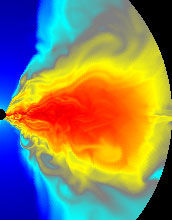Multimedia Gallery
Simulation of an Accreting Black Hole
Simulation of an Accreting Black Hole
Simulation of an accreting black hole. Black holes are believed to lie at the center of most galaxies in the universe. There, they accumulate mass, feeding on the surrounding plasma. This image shows the density in a section through a numerical model of an accreting black hole. The plasma forms a dense ring (center), surrounding the hole (center left). Magnetic fields embedded in the plasma lead to turbulence and a slow but inexorable shrinking of the ring. It is only within the past four years that algorithms have been successfully developed to model such systems, and that supercomputers have grown fast enough to run the models.
This research was supported by National Science Foundation grants AST 00-93091 and PHY 02-05155. (Date of Image: 2003)
Credit: J. McKinney and C. F. Gammie
Images and other media in the National Science Foundation Multimedia Gallery are available for use in print and electronic material by NSF employees, members of the media, university staff, teachers and the general public. All media in the gallery are intended for personal, educational and nonprofit/non-commercial use only.
Images credited to the National Science Foundation, a federal agency, are in the public domain. The images were created by employees of the United States Government as part of their official duties or prepared by contractors as "works for hire" for NSF. You may freely use NSF-credited images and, at your discretion, credit NSF with a "Courtesy: National Science Foundation" notation.
Additional information about general usage can be found in Conditions.
Also Available:
Download the high-resolution TIF version of the image. (535 KB)
Use your mouse to right-click (Mac users may need to Ctrl-click) the link above and choose the option that will save the file or target to your computer.



